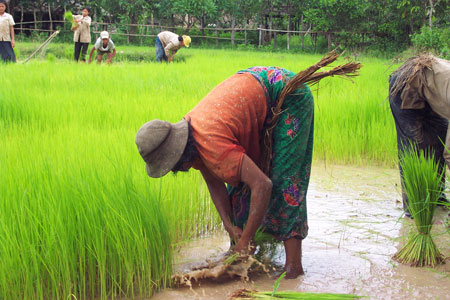November-December 2004
Columban Sisters’ Silver Jubilarians
In the early 1970s the Columban Sisters began a formation program in the Philippines. Filipino Sisters before that trained overseas. We thank Sister Mary O’Dea SSC for contributing the stories of the vocations of three who came through the new program and who have celebrated their Silver Jubilee. You can learn more about the Columban Sisters at www.columbansisters.org andwww.columban.ph
Sister Tammy Saberon
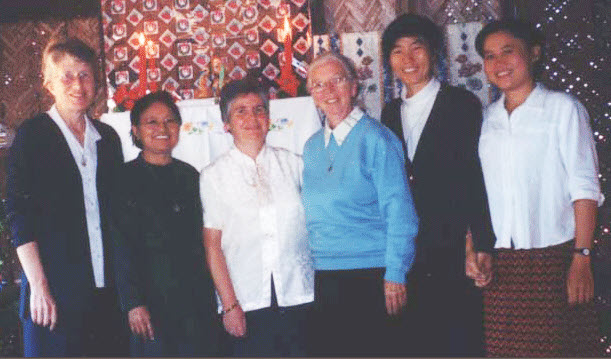
Sr Tammy (2nd L-R with fellow Columban Sisters and companions in Myanmar
Sister Tammy Saberon’s call to become a missionary goes way back - almost to before she was born. Her family lived in Tangub in the Southern Philippines where the Columban Fathers and Sisters had many missions. Tammy’s father used to accompany the local priest, Fr Pat Campion, when he went on his missionary journeys into the mountains. She can still remember her father saying to her mother early one morning ‘These missionaries are like soldiers they leave their families and their countries to go where they were sent- to do God’s work.’ It was as though at that moment the seed of my missionary vocation was sown in my heart.’ Tammy later recalled.
Her early education took place in Molave, Zamboanga del Sur, where the Columban Sisters ran a school. Tammy still remembers one of the sisters, Sister Mary Bernard Quinn, whose prayer life and genuine love for everyone; especially the poor made me a strong impression on her. To quote Tammy herself: ‘Though she never had an opportunity to study the Cebuano language, she was able to relate and communicate with everyone by her love. This genuine love spoke louder than any expert in the language, she was able to relate and communicate with everyone by her love. This genuine love spoke louder than any expert in the language.’
For college, Tammy first studied in Immaculate Conception College, Ozamiz City, run by the Columban Sisters, and completed her education at Notre Dame University, Cotabato City. During this time she becomes deeply aware of God’s personal love for her and she began to study the Bible on a regular basis.
Some years later, the seed that had been sown in early childhood took deeper root and Tammy joined the Columban Sisters. After her initial training as a missionary sister, she was assigned to Hongkong and later to mainland China. Tammy is now part of a small team of Columaban Sisters missioned in Myanmar. There she shares with the people her great love of Scripture through courses and programs.
Looking back on 25 years of missionary religious life, Tammy is most grateful for the blessings that have come to her through the many people who have touched her life in the places where she hase been assigned. She sums it all up in these words: ‘My life belongs to the Lord and to the Mission and that is why I am alive and happy.
You may write to: Sr Tammy Saberon SSC
Sister Perlita Ponge
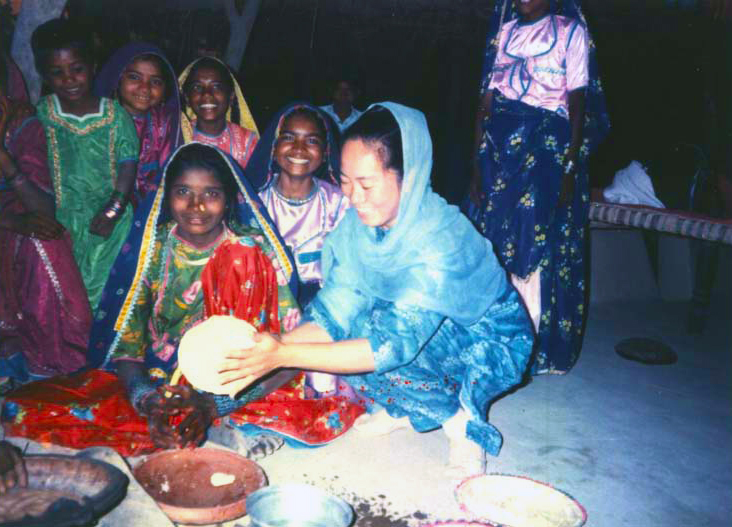
Sr Perlita in Pakistan
I was born in Bangkulasi, Navotas, a suburb of greater Manila. In my family there are three girls and three boys. I attended the local elementary and high school and then went on to study elementary education.
On graduation from college, I went to work on a small island close to my home. I was the first teacher in the area. Here I saw the poverty of the people many of whom could neither read nor write. Yet, these people wanted an education for their children.
In 1975, I joined the Columban Sisters and did my preparation for religious life in Manila. My first assignment outside of the Philippines was in Peru in South America where I worked in a village high in the Andes Mountains. There, the Columban Sisters worked with small communities scattered across the steep hillsides.
I had been in Peru for about seven years when the Columban Sisters decided to go on mission to Pakistan. Sisters interested in this new venture where asked to volunteer. I was one of those who offered to go. It was a total change from Peru.
Pakistan is almost 100 percent Muslim. Since direct preaching of the Gospel is not possible, we endeavor to proclaim the Good News through the ordinary daily interactions of life. Living in a Muslim community, we, too, are the recipients of their goodness and caring. During the invasion of Iraq, when it was dangerous for foreigners to go out on the streets, our Muslim neighbors made sure that we had sufficient food during this difficult time.
At the present time, I am part of the leadership team of the Columban Sisters and live in Handsworth in Birmingham, England, where last year I celebrated my Silver Jubilee as a Columban Sister. What the future holds for me I do not know, but trusting in God will continue to sing: ‘My soul glorifies the Lord. My spirit rejoices I God my Savior.
You may write to: Sr Perlita Ponge SSC
Columban Sisters, 55 Thornhill Road, handsworth
Birmingham B21 9BT, England.
Sister Cecilia Cuizon
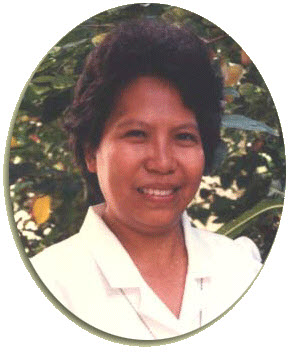 I was born in Labinay, Ozamiz City, the last barrio before Tangub City. Since Tangub is much nearer for us, we do all our business and religious practices there. Mos of us studied in Tangub. I did my secondary schooling in St Michael’s High School, formerly run by the Columban Sisters. That’s how I met the Columban Sisters. Sisters Mary Consuelo Mercado, Claire O’ Rorke, Patrcia McGuinness, Mary Perpetua, Inday Regina Bernad, who became my novice directress later, Mary de Sales and Oliver were the Sisters there in Tangub at different times. My mission was Chile where I bloomed personally and where my call to religious life was most nurtured.
I was born in Labinay, Ozamiz City, the last barrio before Tangub City. Since Tangub is much nearer for us, we do all our business and religious practices there. Mos of us studied in Tangub. I did my secondary schooling in St Michael’s High School, formerly run by the Columban Sisters. That’s how I met the Columban Sisters. Sisters Mary Consuelo Mercado, Claire O’ Rorke, Patrcia McGuinness, Mary Perpetua, Inday Regina Bernad, who became my novice directress later, Mary de Sales and Oliver were the Sisters there in Tangub at different times. My mission was Chile where I bloomed personally and where my call to religious life was most nurtured.
God’s unconditional love shown through people and events stands out for me as I recall my 25 years as a religious sister. For the last 25 years, I have tried to live my motto: ‘My happiness lies in you alone, O Lord’ and, true enough, not for one moment in my 25 years have I felt abandoned or left alone by my God. I might not be the most faithful one but I know my God takes me as I am especially in my worst condition.
You may write Sr Cecilia Cuizon SSC at PO Box 2396, 7200 Ozamiz City, Philippines
Mission Of Life Well Lived
By Sister Rosalie Mujar OSB

Sister Marissa Piramide OSB and Sister Rosalie Mujar OSB, both Missionary Benedictine Sisters of Tutzing, write from different parts of Tanzania and from different perspectives about their experience of trying to adjust to a very different culture.
The former Head-mistress of Sisters’ Secondary Bellarmine Bernas OSB, went back to the Philippines in 1998 and I have been in the post from January 1999 up to the present. This is my last year so I’m trying to put everything in order before I leave in December. After nine consecutive years on the missions, three in Kalumburu, Western Australia and six here in Africa, I feel the need to go back again to the Philippines to refill myself spirituality, physically and professionally if I am to help on the school again.
My nine years were never wasted. I consider them to have been very enriching and faithful. Enriching, because I’ve learned much from the people’s culture to help me understand them better; fruitful, because I’ve been a part of our African Sisters. They will be future agents of change in the different communities or parishes where they will be assigned after finishing their secondary course. Six groups have graduated since1998 and every time I can’t help but feel so proud of the young Sisters. They have struggled all the way in their studies to equip themselves with the knowledge and values that they will need in their future mission work. I congratulate them for their hard earned certificates that indicate their desire to serve and contribute to the Church and their beloved country, but most of all to be better workers of Christ in his vineyard.
As a missionary here in Africa, life can be tough but as the saying goes, ‘Love begets love.’ If you show people love and concern, they will reciprocate with love in their own many, simple ways.
Peter Leonard: Man Of God
By Gonzalo R. Kaamino III

A pioneer missionary of the original Columban spirit, Father Peter Leonard came to the Philippines in the late 1950s, together with a group of the young, idealistic priests, all followers of the mission-vision of Frs John Blowick and Edward Galvin, founders of the Missionay Society of the St Columban. Earlier, the batch of Frs Hennessey, Corrigan, Chapman and the indefatigable, courageous and charismatic Patrick Cronin, paved the way for a much more enlivened missionary zeal. Later the group of Fr Sean Coyle further enriched the growth of the local church.
The things he started
Fr Leonard was instrument in the creation of the seminary on Gango, Ozamis City, as well as the formation of the local clergy in the Archdiocese of Ozamiz and the neighboring dioceses. Following the lead of Vatican II, he empowered the laity through the Christian Formation Center he built that developed local community leaders and strengthened basic ecclesiastical communities (BECs).
In Manila Fr Leonard built the Columban House of Studies in Cubao and worked as a teacher, adviser, spiritual director and confidant to lay missionaries, Sisters, seminarians and fellow priests.
Kind soul
In his simple, charming, gentle and unassuming ways, he endeared himself to people who were privileged to meet him. He was the epitome of simplicity and kindness. I was young seminarian in 1995 when I came to him to ask permission for a delegation from Ozamiz to visit the Cubao house. Without a second thought and with his characteristic smile, he welcomed the 50 Ozamiznons.
When my mother was refused a visa by the US embassy in her plan to go abroad, Fr Leonard offered her a teaching job in China to assuage her low spirits.
His last visit
When he came to Ozamiz at Christmas 2002, he visited my family especially because my younger brother was a Columban seminarian, and to finalize my mother’s papers for China. It was his last visit to people who loved him dearly as a friend, father and inspiration.
In the hands of God
Fr Leonard died suddenly on January 2003 in Ozamiz, a place he surely loved, among people close to his heart. With heartfelt sadness because of the empty place he left in our hearts, we bade a good priest adieu. But we are so happy in the thought that he is now in the bossom of the Father, face-to-face with God whom he lovingly and faithfully served.
The Year Of Rice
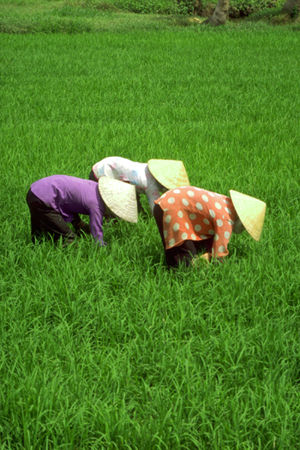
It is rare for the United Nations to devote a year to a single crop. In the past the tendency has been to nominate particular types of people each year. One was named for women, another for the disabled, then a year for indigenous peoples and for volunteers. But in a recent change in emphasis we celebrated water in 2003 and this year, rice. There is a continuity between the two. Water-systems make the growth rice possible and Diouf told the United Nations that ‘it is the staple food of more than half the world’s population and almost a billion household in Asia, Africa and Americas depends on rice systems for their source of employment and livelihood.’
In its declaration, the United Nations states that the ‘land and water resources for rice production are diminishing even as the world population continues to grow.’ The resolution to dedicate this year was presented to the United Nation Food and Agricultural Organization by 44 member nations. They are currently deeply concerned and predicting a pending crisis in supply. In addition they noted that ‘rice systems support a wide variety of plants and animals, also helping supplement rural diets and incomes. It is therefore in the frontline in the fight against world anger and poverty.’
It is the ambition of the United Nations to ‘engage the entire community of stakeholders, from rural farmers to the scientific institutions that mapped the rice genome, in the mission to increase its production in a manner that promotes sustainability and equity.’ However, to date, their officials have made no prediction as to whether or not they intend to go down the path of agro-chemicals and genetically engineered modifies crops. If they do, there is serious doubt these strategies would lessen hunger, but rather merely create new profit system.
Genetically engineered crops are patented -- that is owned by foreign multinational companies. You have to pay but in will be captive to these companies when their own traditional seeds disappear. This will especially be true if their plans to promote the ‘terminator seeds’ -- those which don’t reproduce -- are introduced. Each time farmer’s plant they will have to buy the new seeds.
This will mean increased poverty for farmers and huge profits for the seed companies. Genetically engineered crops need herbicides to be successful. This is bad for the soil and for the rice, as both will be contaminated. If rice is life then genetically engineered rice is death for the rice farmers.
For the Philippines to survive, it needs to have a sustainable system of rice farming. Traditional varieties which have survived thousands of years are a priceless heritage and must be preserved. Organically grown traditional varieties, not reliant on expensive genetically engineered seeds and herbicides, are the best hope for a healthy, thriving Philippines. Rice is Life.
Too Good To Be False
by Fr. Horacio de la Costa, SJ
Christmas is when we celebrate the unexpected -- it is the festival of surprise.
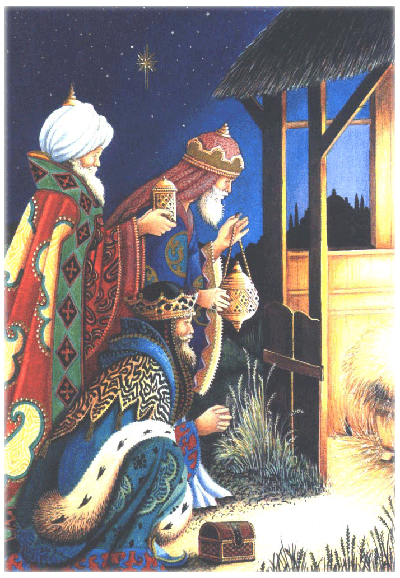 This is the night when shepherds wake to the song of angels; when the earth has a star for a satellite; when wise men go on a fool's errand, bringing gifts to a Prince they have not seen in a country they do not know.
This is the night when shepherds wake to the song of angels; when the earth has a star for a satellite; when wise men go on a fool's errand, bringing gifts to a Prince they have not seen in a country they do not know.
Night of all nights
This is the night when one small donkey bears on his back the weight of the world's desire, and an ox plays host to the Lord of the heaven. This is the night we are told to seek our king not in a palace but a stable; and although we have stood here, year after year, as our fathers before us, the wonder has not faded nor will it ever fade; the wonder of that moment when we push open the little door, and enter, and entering find in the arms of a Mother who is a Virgin, a Baby who is God.
The homeless God
G.K. Chesterton has said it all for all of us: the only way to view Christmas properly is to stand on one's head. Was there ever a house more topsy-turvy than the House of Christmas, the Cave where Christ was born? For here, suddenly in the very heart of earth, is heaven; down is up and up is down; the angels and the stars look down on the God who made them and God looks up at the things He made. There is no room in an inn for Him who made room, and to spare, for the Milky Way! And where God is homeless, all men are at home.
Gifts we don't expect
We were promised a Saviour, but we never dreamed that God himself would come to save us. We knew that He loved us, but we never dared to think that He loved us so much as to become like us. But that is the way God gives. His gifts are never quite what we expect but always something better, something far better than we hope for. We can only dream of things too good to be true; God has a habit of giving things too good to be false.
What we need
That is why our Christian faith is the faith in the unexpected, a religion of surprise. Now more than ever, living in times so troubled, facing a future so uncertain, we need such faith. We need it for ourselves and we need it to give others. We must remind the world that if Christmas comes in the dead of winter, it is that there may be an Easter in the spring.
